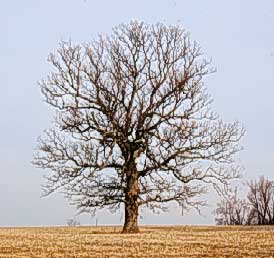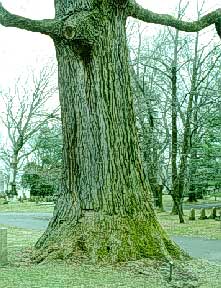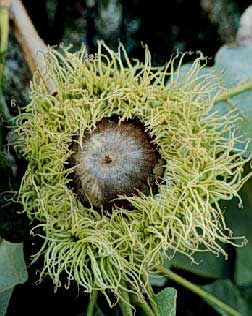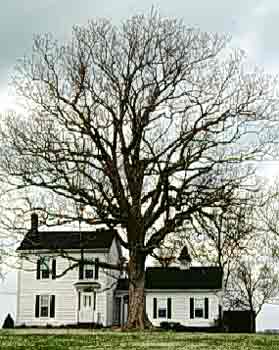 Bur Oak - Quercus macrocarpa
Bur Oak - Quercus macrocarpa
Beech Family (Fagaceae)
Bur oak is named for the characteristic fringed cup around its acorn. It grows very well in open areas, especially the Bluegrass region of Kentucky. Large stately trees (some hundreds of years old) grow in open horse pastures and old estates. The Kentucky champion tree is in Bourbon County, is over 95 feet tall and rivals the size of other bur oaks in the USA.
- Native habitat: Nova Scotia to Pennsylvania, west to Manitoba and Texas.
- Growth habit: This tree has an irregular, open crown with coarse, broad-spreading limbs and a massive trunk.
- Tree size: A slow-growing tree, it can reach 70 to 80 feet in height and width. This tree may live hundreds of years. It can exceed 100 feet in height.
- Flower and fruit: Female flowers are inconspicuous. Pendulous male catkins are yellow-green. The 3/4 to 1½ -inch-long acorn is half covered by a fringed cap.
- Leaf: Leaves are 4 to 12 inches long, lobed and shaped like a base fiddle. The beautiful leaf is glossy and smooth above while pale and hairy below. Fall color is a dull yellow to yellow-brown.
- Hardiness: Winter hardy to USDA Zone 3.
The massive root system of the bur oak is said to be a mirror reflection of the trunk and branch system above ground. With this extensive root system it is not surprising that the bur oak is the dominant tree of midwestern prairies, often considered the advancing pioneer species. Remaining trees are considered the most fire-resistant, having withstood the ravages of periodic prairie fires. The root system of bur oak successfully competes with prairie grass roots as well as neighboring bur oaks. Intense root competition keeps bur oaks scattered apart from each other throughout the savanna.
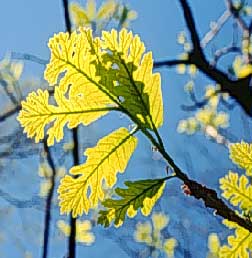 Bur oak seedlings cannot survive in the shade of a dense forest. Because the species is not reseeding itself as fast as individuals are dying, planting bur oak in the landscape is encouraged. In Kentucky, bur oak was once common in the Bluegrass region and some stately trees remain standing.
Bur oak seedlings cannot survive in the shade of a dense forest. Because the species is not reseeding itself as fast as individuals are dying, planting bur oak in the landscape is encouraged. In Kentucky, bur oak was once common in the Bluegrass region and some stately trees remain standing.
The national champion bur oak (96 feet tall, 103-foot spread) is in Paris, Ky.


